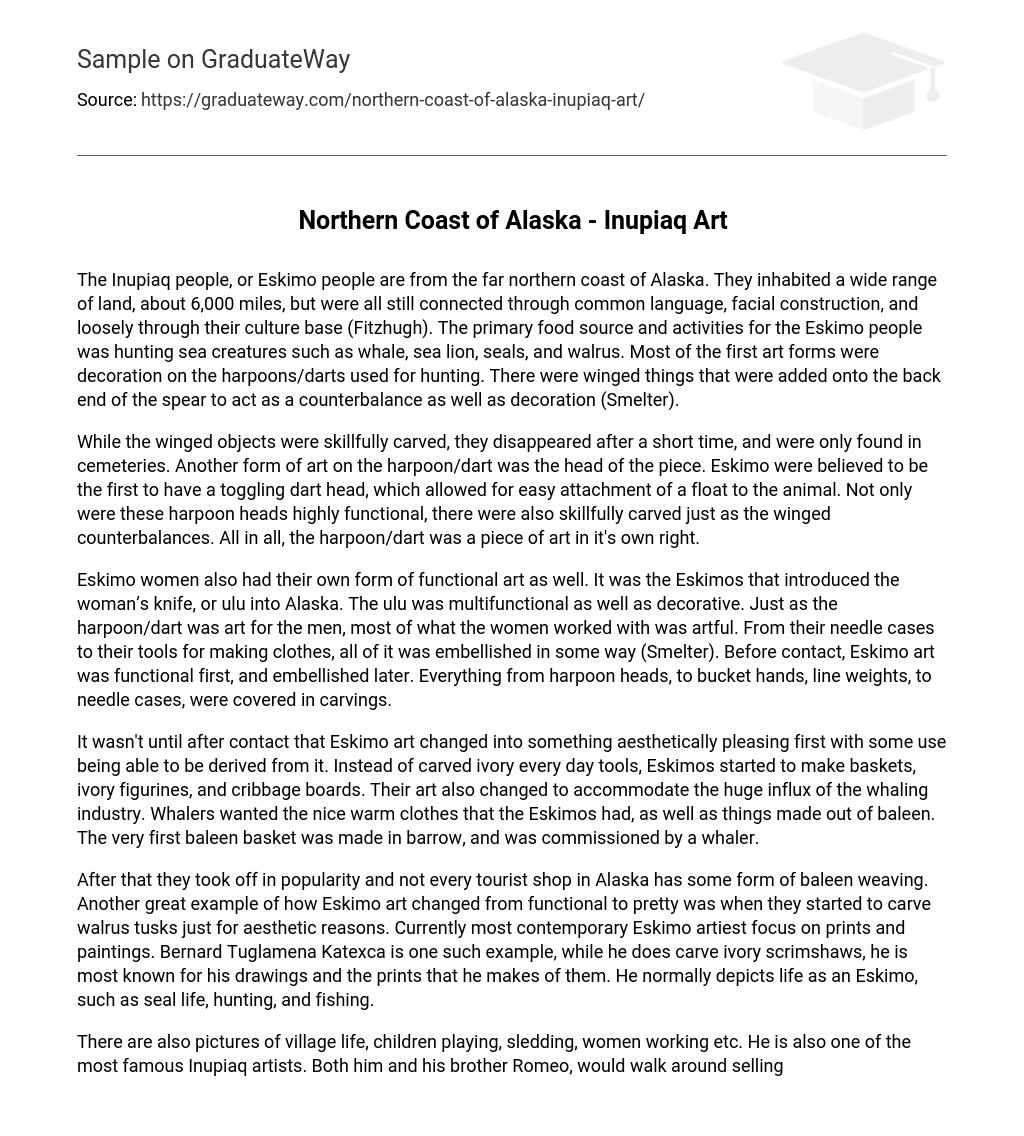The Inupiaq people, also known as Eskimo people, originate from the northern coastal region of Alaska, spanning a vast land area of approximately 6,000 miles. Despite their geographical spread, they share a common language, facial features, and to some extent, cultural traditions (Fitzhugh). Their main sustenance and activities revolved around hunting marine creatures such as whales, sea lions, seals, and walruses. The initial artistic expressions among the Eskimo people were primarily found in the form of embellishments on their hunting harpoons and darts. These decorative elements included wing-shaped attachments at the back end of the spears, serving both as a counterbalance and as ornamentation (Smelter).
Although the winged objects were expertly carved, they would vanish quickly and were exclusively discovered in cemeteries. The harpoon/dart also featured another artistic element in the form of its head. The Eskimo people were credited with inventing the toggling dart head, which made it simple to attach a float to the animal. In addition to being highly functional, these harpoon heads were also intricately carved, similar to the winged counterbalances. Ultimately, the harpoon/dart itself was considered a work of art.
Eskimo women also had their own form of functional art. They introduced the woman’s knife, or ulu, into Alaska. The ulu served multiple purposes and was also adorned with decorative elements. Similarly, the men’s art focused on the aesthetics of the harpoon/dart, while the women’s work was primarily artistic. The women embellished all their tools, from needle cases to clothes-making utensils. Before contact, Eskimo art prioritized functionality and decoration came second. Carvings adorned various items such as harpoon heads, bucket hands, line weights, and needle cases.
Initially, Eskimo art primarily served utilitarian purposes, with carvings of everyday tools made from ivory. However, following contact with outsiders, the art form underwent a transformation into something visually pleasing. Alongside this shift, Eskimos began creating other artistic items such as baskets, ivory figurines, and cribbage boards. Additionally, the influence of the whaling industry led to further changes in Eskimo art. Whalers desired the warm clothing and baleen-made items produced by the Eskimos. As a result, the first baleen basket was crafted in Barrow upon commission from a whaler.
After becoming popular, baleen weaving became available in every tourist shop in Alaska. Eskimo art also transitioned from functional to decorative with the carving of walrus tusks purely for aesthetic purposes. Presently, contemporary Eskimo artists primarily concentrate on creating prints and paintings. Bernard Tuglamena Katexca is a notable artist who not only carves ivory scrimshaws but is renowned for his drawings and the prints he produces from them. His artwork typically portrays aspects of Eskimo life, including seal life, hunting, and fishing.
There are also pictures of village life, children playing, sledding, women working etc. He is also one of the most famous Inupiaq artists. Both he and his brother Romeo, would walk around selling their artwork out of a little suitcase. Their art is highly prized and sought after. Sonya Kelliher- Combs is another contemporary artist who is very well known for a completely different reason. Sonya does paintings, but also sculptures she calls her “secrets”. She bases her artwork off of the idea of “of bags and baggage and the things one carries along”(Decker).
Her artwork depicts a stylized portrayal of Eskimo life, showcasing their customs and traditions. One of her notable creations are secrets which are crafted from animal intestine, inflated, dried, and adorned with porcupine quills. Additionally, she has also created a piece named “Idiot Strings” that features mittens made from animal hide, connected by rawhide strands. This particular artwork holds significant meaning as it symbolizes the universal presence of idiot strings in cold regions where people wear mittens, ultimately representing the interconnectedness of individuals and their surroundings.
Works Cited
Decker, Julie. “Guarded Secrets: Art of Sonya Kelliher-Combs.” Print.
Smelter, John. “Contemporary Inupiaq Art” Lecture.
Smelter, John. “Pre-Contact Inupiaq Art” Lecture.
Smelter, John. “Post-Contact Inupiaq Art” lecture.
Fitzhugh, William. Eskimos: Hunters of the frozen coast. Web.





